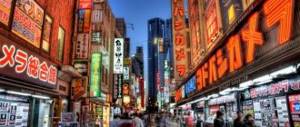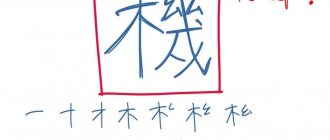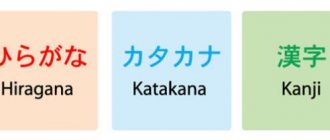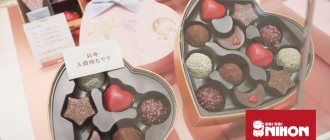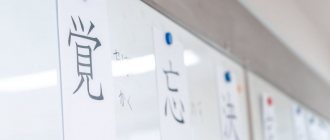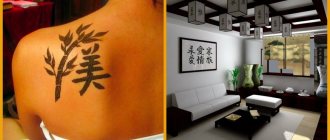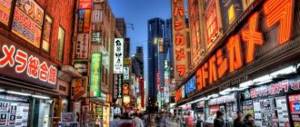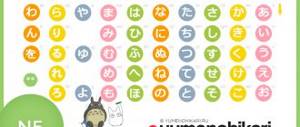The Japanese alphabet is the first thing a person encounters who wants to learn the language of the Land of the Rising Sun. Many European countries use the Latin alphabet (with minor changes and additions), so the period of first occurrence is easy. In Japanese, the situation is different - the Japanese alphabet consists of two sets of characters (katakana and hiragana). They are both necessary for further language acquisition.
Japanese writing
Features of the Japanese alphabet
Japanese letters are symbols that are unusual for us in everyday life. Basically, they encode not one letter, but a syllable at once - although there are exceptions. There is one set of syllables for which two alphabets were invented - katakana and hiragana. Each set includes 46 characters. The summary table is called gojuon.
Hiragana - alphabetical elements necessary for writing suffixes, particles, prefixes. Previously, it was considered a women's alphabet, but is now used even to write down entire words - for example, by small children. At the beginning of learning the language of the Land of the Rising Sun, people focus on hiragana as the simplest. The writing capabilities are sufficient for writing and constructing simple sentences.
The Japanese school is designed in such a way that children who have mastered hiragana begin to study katakana, and at the next stage move on to kanji. Katakana is primarily used to write borrowed words. In the past, it was the main one and was considered the male alphabet. A special feature of katakana is the additional rows of symbols. They were invented in the 20th century, when Japan encountered other powers and borrowed many words with unusual sounds that required a method of transmission in writing.
Japanese writing characters
Syllabic alphabet reflect the peculiarity of the language system - it is syllabic, consisting of syllables. If six elements are used to write the word “sakura” in Russian, three are enough for the Japanese. The syllables of the language are open. There are symbols that mean only one sound: all vowels and “n”.
The sounds, taking into account which the gojuon table is compiled, are divided into three groups:
- consonants;
- vowels (a, i, u, e, o);
- semivowels (th, w).
Combinations of sounds form the phonetic alphabet of gojuon. It consists of rows with the same consonants and columns with the same vowels. Gojuon is written in hiragana and katakana.
There are no syllables with “l” in the sign table, since this sound does not exist in the language. In a borrowed word it is usually transformed into a sound close to a soft “r”. In addition, foreign words are often abbreviated so much that it is almost impossible to guess the ancestor.
Gojuon
How to actually teach them
Let's tell you a little secret - despite all the complex rules and some exceptions, learning hiragana and katakana is a fairly quick and painless process if you approach it correctly. It is quite possible to spend two days studying each alphabet, another three days on repetition, and after a week you will be able to read hiragana and katakana quite well. In a week of practice, you will still read at the speed of a child starting to learn a language, but you will no longer get confused and peek at the table. The main thing to do is to read the words in Hiragana and Katakana and repeat them periodically. Kanjiway will help you with initial learning of the alphabet, reading words in Hiragana and Katakana, and will also determine when it is best for you to repeat them. We use spaced repetition systems to match you with the exact letters and words that will help you remember the information you've learned. If you spend 30 minutes a day on Kanjiway , you can learn hiragana and katakana in just a week or less.
Hiragana alphabet with Russian transcription
Usually, learning the Japanese alphabet using tables with translation into Russian begins with hiragana. It includes 46 characters and is used when writing endings, postfixes, and conjunctions. Sometimes hiragana replaces hieroglyphs. This is not very literate, but acceptable for foreigners and children. The writing system clearly reflects the pronunciation of the word, with minimal differences in spelling and sound.
Features of the alphabet:
- one character – one syllable (except for vowels and “n”);
- one syllable – one constant pronunciation, independent of the position in the word and neighboring elements;
- main consonants are soft;
- hard consonants are obtained by adding additional characters to the symbols of syllables with soft consonants;
- With the consonant “v” only the vowel “a” is used; there are no other syllables with this letter.
Hiragana will use not only readable characters, but also one special one, introduced as an indicator of doubling of the character behind it. Visually it resembles “tsu”, but is half the size of this element. The only purpose of the symbol is to indicate that the next vowel must be pronounced double.
Hiragana and Russian transcription
How is hiragana used?
Since hiragana forms the basis of written Japanese, there are several cases where it plays an important role: Furigana Furigana is, simply put, a guide to the pronunciation of difficult Japanese words, written as small hiragana characters above or to the side of the kanji characters. Kanji are complex Chinese characters that represent entire words and are most often used in texts. If you can't read the kanji, there will most likely be furigana characters nearby for a clue. You can also see furigana in Japanese lessons in the LingQ library.
Suffixes (and Sentence Separators) Suffixes play an important role in Japanese grammar. They are added at the end of a word and thus indicate what part of speech it is - a noun, an adverb or a verb. The most common suffixes are は (wa), が (ga), and を (wo). They also help you understand the flow of words in written text because words are not separated by spaces. The suffix placement and grammatical hiragana (below) show where the word ends. Polyglot Steve Kaufmann made an excellent video on suffixes in Japanese on his YouTube channel.
Hiragana grammar is also an important part of sentence grammatical structure. Since whole words are most often written as kanji characters, hiragana is used to indicate the grammatical role of a word in a sentence, such as tense or participial construction. For example, 勉強 (ben'kyu) means 'learning' in noun form. The present tense of a verb is made by adding している (shiteiru) to the noun, becoming 勉強している (ben'kyū shiteiru) or 'studying'.
Katakana alphabet with Russian transcription
Katakana is a Japanese syllabary alphabet, previously considered masculine. Now it is used to record names and borrowed words. In the traditional educational system of the Japanese school, the study of katakana follows the mastery of hiragana. As a rule, everything falls on one grade of elementary school - the first. Some children learn the alphabet earlier.
Visually, katakana symbols are very different from those discussed above - they are sharp and consist of straight lines. The external difference should not be deceiving: every katakana character has a counterpart in hiragana. Both systems of writing words originated from hieroglyphs (hiragana - from cursive writing, katakana - from parts).
Katakana is needed to write names. It is often used to write the names of plants, animals, and birds. Hieroglyphs denoting such objects are very rare, so the use of the alphabet simplifies the task of reading and understanding. Sometimes katakana is substituted for kanji or used to create emphasis on a particular word. Katakana can also reflect the speaker’s accent if the text conveys someone’s speech.
The main difficulty of katakana is the similarity of some characters. A special feature is the presence of a symbol that displays the longitude of the sound. Visually, the sign resembles a dash.
Katakana and Russian transcription
Hiragana table
The English language consists of vowels and consonants. Hiragana is structured a little differently, in which characters are grouped in table form depending on the sounds they represent.
This table is called Gojuon, which literally translates as “table of 50 sounds.” Each row has the same first consonant, and the columns contain the same vowel sounds.
The first row of this table contains vowel sounds: あ (a), い (i), う (u), え (e), お (o). These vowel sounds determine the order of the letters in all subsequent rows, grouped according to their consonant and vowel sounds: each row always contains the same consonant, and the columns always have the same vowel sound. This makes five letters in a row (except for the rows starting with Y and W).
Hiragana Table: Gojuon
| A | I | U | E | O | |
| K | か | き | く | け | こ |
| S | さ | し | す | せ | そ |
| T | た | ち | つ | て | と |
| N | な | に | ぬ | ね | の |
| H | は | ひ | ふ | へ | ほ |
| M | ま | み | む | め | も |
| Y | や | ゆ | よ | ||
| R | ら | り | る | れ | ろ |
| W | わ | を | |||
| *N | *ん |
*The ん, or 'N' sound does not have a vowel associated with it. It is pronounced in the same way as the English 'N.'
*The sound ん or 'N' does not have a paired vowel. He pronounces it the same way as the English 'N'. Now that we've got the table structure down, it's time to move on to pronunciation!
How to quickly learn Japanese letters and alphabet
As linguists advise, the most reliable way to learn the alphabet is persistent, purposeful, methodical memorization of symbols combined with constant practice of application. Special applications for practicing signs will help you master writing. There are several programs for telephones and personal computers. Some are available for free, while others have limited or no free functionality. Regular repetition forms a habit, and the speed of recognition increases over time so much that reading turns into a simple task.
Studying Japanese writing
Study method
The easiest way is to master it with a teacher. Private teaching is widespread. There are courses, a set of groups of students. Private study is available, in which the teacher focuses on only one student. Both options are practiced both offline and online. Training with a mentor is the best and most effective option, although it is relatively expensive.
Learning the alphabet on your own does not require such costs. The most effective way is cards (paper or electronic). This is what is implemented in most applications. You can make the cards yourself - it involves rote memory.
How to make cards:
- cut 46 small pieces of paper;
- On each one, write the kana sign on one side, and reading on the reverse;
- pull out cards in random order, recognizing the reading of the sign by the writing.
It is recommended to first master one alphabet, then move on to the second.
In order for kana to be better absorbed, it is necessary to constantly practice the acquired skills by reading simple texts in Japanese, written in alphabet. Textbooks, tutorials, and children's books will help.
Kana cards
Vowel sounds
In English, we learn vowels in this order: A, E, I, O, U. In Japanese, the alphabet is in a slightly different order - A, I, U, E, O - how to pronounce (ah, ee, oo, eh oh).
あ – 'a' as in 'car' い – 'ee' as in 'macaroni' う – 'oo' as in 'tutu' え – 'eh' as in 'get' お – 'oh' as in the word 'coffee'
As you learn the remaining letters, remember that they will all have the same vowel sound from the chart. In the case of vowels, the sound does not change. Once you learn how to pronounce them, you can pronounce any character! Let's move on now to whole syllables with consonants.
Syllables starting with 'K'か – 'ka' as in 'car' き– 'ki' as in 'key' く– 'ku' as in 'coop' け– 'ke' as in 'kept' ' こ– 'ko' as in 'coffee'
Syllables starting with 'S'さ– 'sa' as in 'socks' し– 'shi' as in 'she' す– 'su' as in 'suit' せ– 'se' as in 'seven'そ– 'so' as in 'soda' * Note: There is no 'si' sound in Japanese
Syllables starting with 'T'た– 'ta' as in 'taco' *ち– 'chi' as in 'cheek' *つ– 'tsu' as in 't's' in 'that's' + 'u' ( tsunami) て– 'te' as in 'text' と– 'to' as in 'tomato * Note: The 't' sound in Japanese is not aspirated as in English. It sounds more like the 't' in 'caterpillar' than in 'taco.' *Note: There are no 'ti' or 'tu' syllables in Japanese
Syllables starting with 'N'– 'na' as in 'not' に– 'ni' as in 'knee' ぬ– 'nu' as in 'new' ね– 'ne' as in 'neck ' の– 'no' as in 'note'
Syllables starting with 'H'は– 'ha' as in 'ha ha ha!' (laughter). ひ– 'hi' as in 'he' *ふ– 'fu' – *see note へ– 'a' as in 'car' ほ– 'a' as in 'car' *Note: There is no sound in Japanese 'hu', this character is more like a cross between 'f' and 'h'. In traditional Japanese, it is closer to the 'fu' sound, which in English is used in words beginning with these letters, such as 'hook' and 'football.'
Syllables starting with 'M'ま– 'ma' as in 'mom' み– 'mi' as in 'me' む– 'mu' as in 'moo' め– 'me' as in 'men ' も– 'mo' as in 'most'
Syllables starting with 'Y'や– 'ya' as in 'yacht' よ– 'yo' as in 'yogurt' * Note: Japanese does not have the sounds 'yi,' 'yu' and 'ye', they are found only in foreign words and indicated using katakana.
Syllables starting with 'R'ら– 'ra' as in 'rock' り– 'ri' as in 'reed' る– 'ru' as in 'root' れ– 're' as in 'red ' ろ– 'ro' as in 'rope'
* Syllables starting with 'W'わ– 'wa' as in 'watch' *を– 'oh' as in 'coffee' * Note: Japanese does not have the sounds 'wi,' 'wu' and 'we' . *を is pronounced the same as お, but is used only as a suffix. You will never see it in ordinary words that use お.
ん– 'n' as in 'on' * Note: This is the only character in Japanese without a vowel sound. It is pronounced like the English 'n', but in certain cases it can be pronounced like 'm'.
Dictionaries and translators
Dictionaries are available in paper and electronic formats; the latter work offline or online only. Just a few decades ago there were very few dictionary options, but in recent years the choice has become much wider.
Among the paper ones, the most famous are:
- Large Japanese-Russian dictionary (two volumes);
- Japanese-Russian scientific and technical hieroglyphic dictionary (two volumes);
- Japanese-Russian dictionary "Sanseido".
Among the electronic dictionaries that audiences love are:
- Yarksi;
- WWWJDIC;
- Nihon Moji.
Japanese translators mainly work online. Known Resources:
- yakusu.ru;
- nihongo.aikidoka.ru;
- warodai.ru.
Previously, portable electronic translators from Casio were widely used, but in recent years their popularity has waned, but the online translator from Google is conquering new heights, being able not only to translate the entered text, but also to identify characters on paper through a camera.
Which of the dictionaries and translators to use in their studies is up to the student to decide. Ordinary books are good for accuracy and reliability. They make it easier to remember the spelling of a symbol, but interaction takes time. Online dictionaries are larger, work automatically, require a minimum of time to search for a sign, and are updated regularly. There is a fly in the ointment: most programs require an Internet connection, and translations are not always accurate.
Voiced sounds (Dakuon)
Dakuon is a voiced sound that begins with k, s, t and h. Dakuon is indicated by two small apostrophes that look like quotation marks at the top right of the letter. They are not shown in the hiragana table because they are the same as the series beginning with the letters k, s, t and h, differing only in the apostrophe in the upper right corner of the character.
Voiced sounds are obtained based on the table as follows: k→gs→zt→d/ch/jh→f
*Note that じ and ぢ (ji) are pronounced the same, and the sounds ず (zu) and づ (dzu) are very similar, only the z sound in dzu is slightly stronger.
Syllables starting with 'G'が – 'ga' as in 'gaga' ぎ – 'gi' as in 'geese' ぐ – 'gu' as in 'goop' げ – 'ge' as in 'get' ' ご – 'go' as in 'goat'
Syllables starting with 'Z'ざ – 'za' as in 'bizzare' *じ – 'ji' as in 'jeep' ず – 'zu' as in 'zoo' ぜ – 'ze' as in ' zest' ぞ – 'a' as in 'zone' * Note: There is no 'zi' sound in Japanese
Syllables starting with 'D'だ – 'da' as in 'dock' *ぢ – 'ji' as in 'jeep' *づ – 'dzu' as in 'zoo' with a 'd' in front で – 'de' as in 'deck' ど – 'do' as in 'door' *Note: There is no 'di' sound in Japanese
Syllables starting with 'B'ば – 'ba' as in 'body' び – 'bi' as in 'beach' ぶ – 'bu' as in 'boom' べ – 'be' as in 'bed ' ぼ – 'bo' as in 'boy'
Handakuon: Syllables starting with 'P' Handakuon are the sounds of the 'h' series, only with a small circle in the upper right corner. They are pronounced like a 'p' sound.
ぱ – 'pa' as in 'papa' ぴ – 'pi' as in 'pea' ぷ – 'pu' as in 'puma ぺ – 'pe' as in 'pet' ぽ – 'po' as in the word 'pop'
ひらがな
Hiragana is used to write inflected parts of words, grammatical particles, or words whose hieroglyphic spelling has fallen out of use.
Hiragana characters are characterized by rounded, soft writing. Hiragana (平仮名) is translated from Japanese as “smooth alphabet” - that is, not “angular” like Katakana (片仮名). Hiragana was used by female authors of diaries and novels in the 9th to 12th centuries. Japanese poetry was written with it. Hiragana was a kind of “lightweight” letter, since it was believed that hieroglyphs for women were very difficult.
about how to easily and quickly remember the Hiragana alphabet in this video.
Katakana
Katakana is the second syllabary of the Japanese language. Its characters are read exactly the same as hiragana, but are written differently. Hiragana: く (ku), る (ru), ま (ma), and katakana: ク (ku), ル (ru), マ (ma). Katakana can be distinguished from hiragana by the fact that its writing has many more sharp corners.
The main use of katakana is to write words that came into Japanese from other languages.
- レストラン (resutoran) - restaurant
- アメリカ (amerika) - America
- ロシア (roshia) - Russia
- スパゲッティ (supagetti) - spaghetti
- カメラ (kamera) - camera
- コンピューター (konpyuutaa) - computer
In this case, we gave an example of words that are understandable to a Russian-speaking person. All these words (except Russia) did not originate in Russia, but came into the Russian language from other countries. Most often, words written in katakana come from English. So, if you know English and can read katanana, then you can automatically understand some words.
The Japanese read words with their own accent. That is, if you want to sound like a Japanese, then when using Japanese speech you will have to pronounce not “Russia”, as we are used to, but roshia, with the sound “sch”. If you come to Japan, your name will also be written in katakana.
Also among Japanese youth, katakana is considered a “cooler” way of writing words. In manga, words such as “boom”, “gryas”, “bdyshch” are written in katakana.
Katakana - syllabary for children and transliteration
Online resources for katakana:
|
In one book I read a recommendation to study hiragana first, then katakana. But for me personally, it’s more effective exactly the other way around, because... It is difficult to find mnemonic images for ornate hiragana characters, but easy to find for simpler katakana characters (at least for half of the characters). Oh, because Some of the signs of both kana are mutually similar, then after quickly mastering the “kata” it will be easier for you to start memorizing “hiru”.
Here are my mnemonics in katakana (at first I came up with it myself, then I borrowed successful mnemonics from Stout’s book):
- ワ va - VALIK; Valenok; Wow!
- ラ ra - the crayfish is boiling (lifting the lid); robber (masked)
- I ヤ - “Yes, it’s ME!”; Fury bursts from the chest; scimitar
- ma マ - tangerine seed; sail on the mast
- ha
ハ - robe wide open; WAVE - na
ナ - insect, string; our hanger (stuffed animal, knife); cross - ta タ - slipper; that Leaning Tower of Pisa
- sa サ - sled on top; barn (its door or fence nearby); Bench (without K)
- ka
カ - KATANA, POCKET; like (without top line) - a ア - stork on the roof; rock
- ri リ - rice shoots, marks (serifs, dashes)
- mi ミ - sweet stroke :); mustache of a CUTE cat; three flashes
- hee ヒ - the sly one giggles while driving
- ni
ニ - two threads, ni = 2 - ti チ - quiet in the churchyard; target at the shooting range; crossed out DASH; Tiger striped on top
- si シ - tits :), cigarettes in the palm of your hand; beautiful smile
- ki キ - brush; mast at KIL; throw
- and イ - i with a bar; music stand; ibis stands
- ru
ル - HANDS; RUslo; Such roots cannot be cut down quickly - yu ユ — yulu launchYu (pressYu); funny gallows without rope
- mu ム - sift flour with a sieve
- fu フ - “Fu, sharp angle!”
- well ヌ — ; Well, seven!
- tsu ツ - zucchini, candied fruits (?); tsunami (with 2 drops)
- su ス - stern judge in a hat
- ku ク - ; SECOND, short seven
- u
ウ - iron - re レ - cut with a knife; RIVER meander; raindrops perform rap
- me メ - sword
- he ヘ - hill starting with the letter He; HuangHe bend
- ne
ネ - NEtsuke - te
テ - letter TE; telephone - se セ - ; sandwich
- ke ケ - Kat; kangaroo
- e エ - eras; these (elevator) doors, this press
- o ヲ - ; Yell with your mouth open and your tongue hanging out
- ro ロ - quadRO music; square mouth; ROBOT head
- ё ヨ - letter Ё inverted; shelves with YOGURT
- mo モ - BRIDGE (section with a pile); skein of thread; can be baited on a hook
- ho ホ - mansions; laughter to tears
- but ノ - But!, stretch out your ACHING back; horse (dog) nose, dorsum of the nose
- to
ト - TOpor, poplar - so
ソ - SOkha; sleep with a smile - ko
コ - box on the side - o
オ - axis; Aspen, Alder, hazel; experienced figure skater (dancer) - n ン - nose with a smile;
It should be noted that some katakana signs are quite similar to each other, differing only in the inclination of the strokes, and, at first, you can make a mistake when you see them. Also, these syllabems can differ by only one line. Therefore, I grouped them into the following groups of similarities, so that the differences can be seen more clearly and remembered in groups, perhaps it will be easier:
- oblique with or without 1-2 dashes: ノ but; ン n, ソ so; シ si, ツ tsu
- stick with a branch: ア a (similar to ヤ i and マ ma), イ i, ト that; (it’s close here ヒ hee)
- stick with crossbar (crooked crosses and swords): ナ na, メ me, ヤ ya, セ se (like ヒ hi)
- complicated crosses: オ o, ホ ho; ネne
- stick with 2 crossbars (double cross): モ mo, チ ti (close to テ te), キ ki
- a pair of sticks (ski tracks): ハ ha, リ ri, ル ru (also close are the one-and-a-half sticks レ re and the crossed two-fingers サ sa and カ ka)
- rotated G with features (left quasi-F): ユ yu (close to エ e), コ ko (close to ロ ro), ヨ yo (similar to ミ mi)
- curves turned G with lines, branches, crossbars: フ fu, ラ ra, ワ wa; ウ u, ク ku, ケ ke; ヲ o, ヌ well (close タ ta), ス su
- ム mu and ヘ he remained outside the groups.
